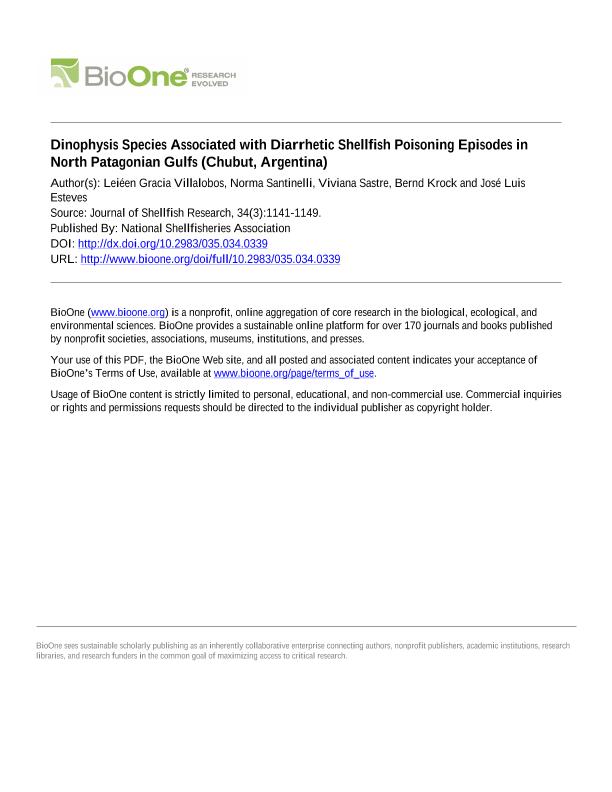Artículo
Dinophysis Species Associated with Diarrhetic Shellfish Poisoning Episodes in North Patagonian Gulfs (Chubut, Argentina)
Gracia Villalobos, Leilen Luciana ; Santinelli, Norma Herminia; Sastre, Alicia Viviana; Krock, Bernd; Esteves, Jose Luis
; Santinelli, Norma Herminia; Sastre, Alicia Viviana; Krock, Bernd; Esteves, Jose Luis
 ; Santinelli, Norma Herminia; Sastre, Alicia Viviana; Krock, Bernd; Esteves, Jose Luis
; Santinelli, Norma Herminia; Sastre, Alicia Viviana; Krock, Bernd; Esteves, Jose Luis
Fecha de publicación:
09/2015
Editorial:
National Shellfisheries Association
Revista:
Journal Of Shellfish Research
ISSN:
0730-8000
e-ISSN:
1943-6319
Idioma:
Inglés
Tipo de recurso:
Artículo publicado
Clasificación temática:
Resumen
The marine dinoflagellate genus Dinophysis Ehrenberg is globally distributed in coastal and oceanic waters and can produce lipophilic toxins. These toxins can accumulate in filter-feeding shellfish and cause diarrhetic shellfish poisoning (DSP). Between 2009 and 2011 the two most frequent and abundant Dinophysis species found in North Patagonian gulfs were Dinophysis tripos Gourret and Dinophysis acuminata Claparéde and Lachmann, and in 2015 D. tripos was the only toxic species found in moderate to high relative abundances when mouse bioassay results for DSP were positive. The positive results from mouse bioassay for DSP agree with moderate to high relative abundances of D. tripos and it was the only potentially toxic Dinophysis species found in the samples. The toxin profiles consisted mainly of pectentoxin-2 (PTX-2) followed by PTX-11 and PTX-2 seco acid. The toxin profiles of the samples could be associated with D. tripos, because the maximum proportion of D. acuminata did not exceed 1.3% of total Dinophysis cells in any of the samples. The results suggest that shellfish accumulated high levels of PTX when D. tripos was at a high abundance. To our knowledge, this is the first record of positive results in the mouse bioassay for DSP related to D. tripos and with closures of shellfish harvesting in North Patagonian gulfs.
Archivos asociados
Licencia
Identificadores
Colecciones
Articulos(CCT-CENPAT)
Articulos de CTRO.CIENTIFICO TECNOL.CONICET - CENPAT
Articulos de CTRO.CIENTIFICO TECNOL.CONICET - CENPAT
Citación
Gracia Villalobos, Leilen Luciana; Santinelli, Norma Herminia; Sastre, Alicia Viviana; Krock, Bernd; Esteves, Jose Luis; Dinophysis Species Associated with Diarrhetic Shellfish Poisoning Episodes in North Patagonian Gulfs (Chubut, Argentina); National Shellfisheries Association; Journal Of Shellfish Research; 34; 3; 9-2015; 1141-1149
Compartir
Altmétricas



